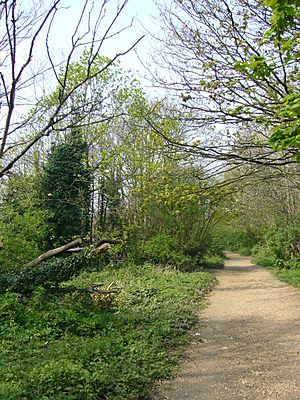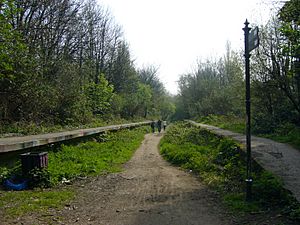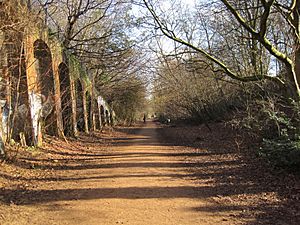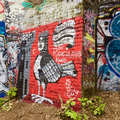Parkland Walk facts for kids
The Parkland Walk is a special path in London. It's about 3.1 miles (5.0 km) long. This path is for walking and cycling. It follows an old railway line that used to connect Finsbury Park and Alexandra Palace. The path goes through areas like Stroud Green, Crouch End, Highgate, and Muswell Hill.
The Parkland Walk uses the old railway bridges and cuttings. But it avoids the closed part of Highgate station and its tunnels. These tunnels are closed for safety. Most of the walk is in Haringey. A small part near Crouch Hill and Crouch End Hill is in Islington. This part includes Crouch Hill Park.
The walk is a local nature reserve. This means it's a protected area for nature. It's also important for nature in London. It became a nature reserve in 1990. It is London's longest nature reserve. Part of the path, from Finsbury Park to Highgate, is also part of the Capital Ring. This is a long walking route around London.
Contents
History of the Parkland Walk
The Old Railway Line
The path from Finsbury Park to Highgate was once a railway line. It was built in the 1860s. The company that built it was the Edgware, Highgate and London Railway. It was meant to go from Finsbury Park to Edgware. But before it opened in 1867, a bigger company bought it. This was the Great Northern Railway (GNR).
Later, other railway lines were added. These went from Finchley to High Barnet and from Highgate to Alexandra Palace. This happened in 1872 and 1873. The GNR later became part of the London & North Eastern Railway (LNER) in 1923.
In the 1930s, London Underground wanted to use these lines. They planned to make them part of the Northern line. This was called "The Northern Heights Plan." But World War II stopped the work. After the war, the plan was dropped.
Passenger trains kept running until July 3, 1954. Then, British Railways stopped them for good. The line to Alexandra Palace closed completely in 1957. But the line from Finsbury Park to Highgate stayed open for freight trains until 1964. Even after freight stopped, the line was used to move empty tube trains. This stopped in 1970 because some bridges were unsafe. The railway tracks were removed in 1972.
How the Walk Was Created
After the tracks were taken away, most of the old station buildings were pulled down. The parts of the line from Finsbury Park to Highgate and from Highgate to Alexandra Palace became the Parkland Walk. The part through the Highgate tunnels was not included.
The Parkland Walk officially opened in 1984. This happened after a lot of work to improve the path. In the late 1980s, there was a plan to build a road where the walk is. But local people protested. A group called The Friends of the Parkland Walk helped organize this. The road plan was stopped. The walk was named a local nature reserve in 1990.
Exploring the Route
Finsbury Park to Crouch Hill
The walk starts near Finsbury Park. You can get on the path from Oxford Road. The path goes up on a raised bank. You can see the back gardens of old houses. It then crosses over Upper Tollington Park on a bridge.
The next bridge goes over Stapleton Hall Road. The Gospel Oak to Barking rail line also passes under this road. The old Stroud Green station used to be here. Its platforms hung over the sides of the bridge. The station master's house is still there at road level. But the station buildings were destroyed in a fire in 1967.
After crossing Mount Pleasant Villas, the path goes into a cutting. This is where the land rises. The path then goes under bridges for Mount View Road and Crouch Hill.
Crouch Hill to Highgate Tunnels
After passing under Crouch Hill, you'll see a large building. This was built for the old Northern Heights railway plan. It's now called The Cape. It has a community energy center, a youth center, and an ecology center. There's also a public cafe you can reach from the walk.
Next, the walk enters Crouch Hill Park. This park is south of the old railway line. It's a triangular park with an area of about 25,730 square meters. It's home to many birds, insects, and bats. You can get into the park from the Parkland Walk. A new building in the park holds Ashmount School, a primary school, and Bowlers Community Nursery.
Before Crouch End station, there's a footbridge over the walk. This bridge is from the original railway days. It connects Hazelemere Road to Crouch Hill Park.
You can still see the old platforms of Crouch End Station. They are partly covered by plants. The path then goes under the old station building and the road bridge for Crouch End Hill.
Beyond this, the path opens up on the north side. It runs next to Hornsey Lane. The path crosses Stanhope Road on a new footbridge. It then goes over Northwood Road on a brick bridge. Only one car can go under this bridge at a time. The land around rises quickly. The path becomes a cutting. At the end, you'll see the entrances to the Highgate tunnels.
You can still see parts of the old electrical equipment from the 1930s railway plan. The tunnels are closed to walkers for safety. The main path ends here. You can exit onto Holmesdale Road. If you want to go further, you can walk up Holmesdale Road. This road joins Archway Road. Walking north on Archway Road, past Highgate station, leads to Muswell Hill Road.
Cranley Gardens to Alexandra Palace
The part of the old railway line between the Highgate Tunnels and the Northern line train depot is still used by trains. The rest of the cutting near Highgate Wood is not officially part of the Parkland Walk. It's allowed to be overgrown.
Another shorter part of the walk starts near Muswell Hill Road. This is where the road crosses the old line. The old Cranley Gardens station area is now a school and houses. The walk continues down steps to the old trackbed towards Alexandra Palace. It goes around a hill.
A long viaduct with seventeen arches goes over St James's Lane. From here, you get a great view over London. The path ends with a rebuilt bridge under Muswell Hill. A primary school has been built on the old trackbed here. The walking path goes around the school and into Alexandra Palace Park. You can still see more parts of the old railway in Alexandra Park. The old Alexandra Palace station building is still there. It's now used for community activities.

Wildlife on the Walk
Plants and Trees
When the railway was running, no trees were allowed to grow near the tracks. But in the last fifty years, many trees have grown here. Most grew naturally, like oak, ash, birch, hawthorn, cherry, apple, holly, rowan, sycamore, and yew. Some trees were planted, like field maple, hazel, and poplar.
More than 300 types of wild flowers have been found on the Parkland Walk. Some are common, and some are more unusual. You might see Michaelmas daisies, goldenrods, buddleia, and Guernsey fleabane.
Animals and Insects
The many different plants support a lot of animals. Twenty-two types of butterfly have been seen here. Hedgehogs live near the walk and sometimes get food from nearby homes. Foxes are common. You might even see a small deer called a muntjac. A group of slowworms (which are legless lizards, not snakes) live along the grassy banks.
More than sixty types of birds have been seen on the walk, and many build their nests here. The Parkland Walk is also very important for bats in London. It's a great place for them to find food and fly safely in the dark. There's a known bat roost nearby.
Sculptures and Local Stories
Just before the old platforms at Crouch End, you'll find a green sculpture. It's a man-sized figure called a spriggan. It was made by Marilyn Collins. It sits in a small space in the wall near the footbridge.
There's a local story about a ghostly 'goat-man'. People said it haunted the walk in the 1970s and 1980s. Kids would dare each other to walk the path in the dark. Some people thought the sculpture inspired Stephen King's short story "Crouch End". But the story was written in 1980, and the sculpture was put up in 1993. So, the sculpture couldn't have inspired the story. However, King did stay with a friend in Crouch End in the 1970s. So, the walk itself might have given him ideas.
Crouch Hill Park Project
The part of the Parkland Walk in Islington was part of a bigger project. This was the Crouch Hill Park project. It aimed to improve buildings for several groups. It also turned an old, unused area south of the Parkland Walk into a public park and nature reserve.
The project built new homes for Ashmount School, a primary school, and Bowlers Community Nursery. It also rebuilt an old building that was once for railway equipment. This building now has a community energy center and a youth center. The whole project cost Islington Council about £13 million.
Some local groups were against the project. But many people supported it, including the school governors and parents. The project was also checked by the Mayor of London. It also got a special grant because it was designed to be "low carbon." This means it uses less energy and is better for the environment.
The new school building was designed to fit the rules for building on protected land. It has a special "brown roof" with plants. It also has climbing plants on its walls. Bowlers Nursery moved into the new building in August 2012. Ashmount School moved there in January 2013. The project finished in February 2013. It won an award for its green design. This included collecting rainwater and using natural air systems. It also has an "energy center" that provides heat and electricity for the area.
Graffiti Art
The local newspaper, Ham & High, has reported on the graffiti on the Parkland Walk. It says the walk has a long history as a place where famous graffiti artists create art in the tunnels. Some local people and the Friends of Parkland Walk see this as a positive thing.











